 From the CEO
From the CEO
We had a good start to our fiscal year, energized by our Team ’24 Europe event in Barcelona. I couldn’t be prouder of all the innovation we’re shipping. Seeing the pure delight on our customers’ faces only increases the fire in our bellies to get after the vast opportunities ahead.
We grew subscription revenue 33% year-over-year in Q1, as we continue to expand within our massive base of over 300,000 customers. I’ve met with dozens of CEOs and CIOs at our largest customers over the past few months and listened to the challenges they face. All are increasingly looking to technology as a way to drive their businesses forward and create a source of competitive differentiation. Across every conversation, my biggest takeaway is their desire to partner more deeply with Atlassian in order to help their teams work better, together.
With technology becoming a more central part of every business, the challenge becomes how to facilitate collaboration between technology and business teams across an organization. Digital transformation and AI adoption aren’t just limited to technology teams; they impact every team. Our platform spans software, IT, and business teams, making Atlassian uniquely positioned to bring these teams together through our differentiated System of Work.

We have built a portfolio powered by the Atlassian cloud platform to help customers of any size, including the largest, most complex enterprises, align work to goals, plan and track work, and unleash their organization’s collective knowledge. Today, roughly 50% of Jira users are from business teams, illustrating how our portfolio of products can bring all types of teams together to solve complex problems.
Atlassian accelerates our collaborative culture, instead of slowing people down. Through working with tech teams, Marketing wants to use Jira. We love that teams can flex Jira however they need to, to improve their processes and speed.”
– Lloyd Jones, Agile and Engineering Practice Manager, Motability Operations
And there’s so much more runway ahead. We are incredibly bullish on our System of Work and continue to innovate to bring this vision to our customers.
This, of course, includes AI, which is already playing a pivotal role in the way work gets done.
 Awe-inspiring AI Announcements
Awe-inspiring AI Announcements
Earlier this month at Team ‘24 Europe, we launched our biggest advancements in AI to date. We’ve been able to ship incredible AI innovation into the hands of our customers quickly due to two major competitive differentiators:
- Our R&D engine means we build and ship fast. We aren’t just marketing AI; we’re delivering real features and benefits that thousands of customers are using today. Atlassian Intelligence usage has increased nearly 10x since the beginning of the calendar year.
- Our 20+ years of data makes for truly unique AI experiences. Our customers can access their first and third-party data across how their teams plan and track work, set goals, and unleash knowledge in a layer we call the “Teamwork Graph.” When a customer’s Teamwork Graph is paired with the power of Atlassian Intelligence, they truly realize what is possible.
Our newest product, Rovo, is built on our unified cloud platform with the power of Atlassian Intelligence and enables teams to unlock organizational knowledge at scale. With Rovo, our customers can now have thousands of specialized agents within their organization, help their teams find knowledge, learn from that knowledge, and, most importantly, act on that knowledge. We’re thrilled to share that in just five months since its announcement, Rovo is now in General Availability for all customers.
Rovo Search is helping our teams find information much faster, reduce cognitive load, and stay in the flow. It’s really promising so far. I don’t foresee a future where we don’t have it.”
– Ronny Katzenberger, Director of Engineering Enablement, Procore
Rovo leverages the Teamwork Graph, meaning it doesn’t just search across Atlassian products, it also pulls data from third-party connectors. Rovo will soon have over 50 connectors across the most popular SaaS applications.
Rovo agents come in three kinds: ‘Out-of-the-Box’, which Atlassian has built; ‘Build Yourself’, which can be built by our customers through code or no code options; and the ever-expanding number of Marketplace agents built by our Marketplace partners, and integrate seamlessly across the Atlassian platform.
Rovo is a game changer. It has already transformed how our teams find and act on information”
– Luke Collins, Senior Solutions Engineer, OVO Energy
We’re also looking to solve developer pain points with AI-powered agents. We recently surveyed thousands of developers and engineering leaders and found that the majority of developers lose 8 hours or more each week due to workflow inefficiencies. To address this, we are introducing two new developer-focused AI agents: Autodev and Autoreview.
Our Autodev agent allows developers to use AI to generate code plans and recommendations, write software, and generate pull requests, all based on the issue description— right within Jira.
Our Autoreview agent allows development teams to automatically gain the skills of a senior, experienced engineer. The agent reviews the code thoroughly and can give detailed feedback, explaining the ‘why’ and providing the direct code changes the developer can accept or tweak before finalizing.
Finally, for Jira Service Management’s over 55,000 (and growing!) customers, we’ve made key advancements in AI-powered support. Forrester recently interviewed a set of Atlassian customers using Jira Service Management’s Virtual Service Agents, and found that a composite organization based on these customers was able to deflect 30% of all requests from its IT service desk, with end users also saving 25 minutes per request1. We are extending Virtual Service Agents beyond Slack into Microsoft Teams and Jira Service Management Help Center so they can reply to emails as well as provide multilingual support. And with the addition of Rovo for Ops agents, teams can dig deeper into incidents, identify subject matter experts, and surface additional resources to fast track resolution.
 More, more, more…from Team ’24 Europe
More, more, more…from Team ’24 Europe
Our R&D machine is delivering new innovation like never before. We’re shipping new products and updates to help technology-driven organizations implement our System of Work.
As part of Atlassian’s increased focus on serving enterprises, we unveiled Atlassian Focus, a new product as part of our Enterprise Strategy and Planning solution for enterprise leaders. According to Gartner®:
By 2025, 70% of digital investments will fail to deliver the expected business outcomes, due to the absence of a strategic portfolio management (SPM) approach.”2
Atlassian Focus ensures people and resources are deployed across the right priorities, providing a central hub to map and track goals, work, teams, and funds against strategic priorities. Focus means leaders can get answers to questions like: ‘Do we have the right people working on the right things?’ ‘What are their goals and do those support our company’s top priorities?’ ‘Are we investing enough in those priorities?’ Focus complements Jira Align’s enterprise planning capabilities by connecting strategic priorities to structured goals, all work, supporting teams, and associated funds.
We also announced Atlassian Home, a single place where employees can go for a personalized view of their work. Atlassian Home connects work across the Atlassian ecosystem with tailored views of Goals, Teams, Projects, and Tasks. Powered by the Teamwork Graph, it delivers personalized experiences based on unified data from all Atlassian products.
And as we deliver more advanced capabilities in higher-level editions of our products, we’re seeing great success with customers climbing the ladder to Premium and Enterprise editions. So we’ve added even more premium offerings to our portfolio:
- Guard Premium unlocks advanced security for customers to protect their Atlassian cloud data, such as more granular data protection policies to block access and certain actions, new detection controls when confidential content is added, and enhanced alert details to investigate suspicious details.
- Jira Product Discovery Premium makes it even easier for organizations to build the right thing at scale via increased visibility, control, and productivity. New AI capabilities further empower product teams to capture and prioritize ideas and insights, ensuring alignment across technical and business teams to help bring new products and features to life.
- Compass Premium unlocks advanced capabilities to help engineering and platform leaders drive change and operate at scale across their engineering organizations. These features empower teams to manage the growing complexity of software development, streamline collaboration, and enhance productivity for software development teams.
Last but not least, across Jira, Confluence, and Loom, we’re constantly improving product experiences for our customers. This consistent reinvestment in product is key in driving sustained durable growth and strong customer retention.
In Jira, we’re bringing new features (and a new look!) that make Jira easier, more flexible, and more powerful for all types of work, and all types of teams. There is now new customizable navigation, new project templates, new AI features, and a completely redesigned UX.
In Confluence, we’re seeing customers consolidate their array of SaaS tools, making Confluence even more central to their collaboration. One of the drivers of this consolidation is Confluence Whiteboards. We’ve added amazing AI capabilities to Whiteboards, so users can generate sticky notes from ideas on pages – or the reverse – summarize a Whiteboard onto a Confluence page. We’re stoked to share that Confluence has surpassed 100,000 customers.
In Loom, we’re rolling out a powerful new Confluence integration that allows teams to record and insert Loom videos directly into Confluence to explain thoughts, provide feedback, and add extra context to their pages. We also welcomed Rewatch to the Atlassian family so customers can harness recording, calendar integration, and AI-powered notetaking capabilities, all directly within Loom. Bug reports and documents can be generated directly from Loom videos, empowering our customers to collaborate in richer, more human ways.
Power in the Platform
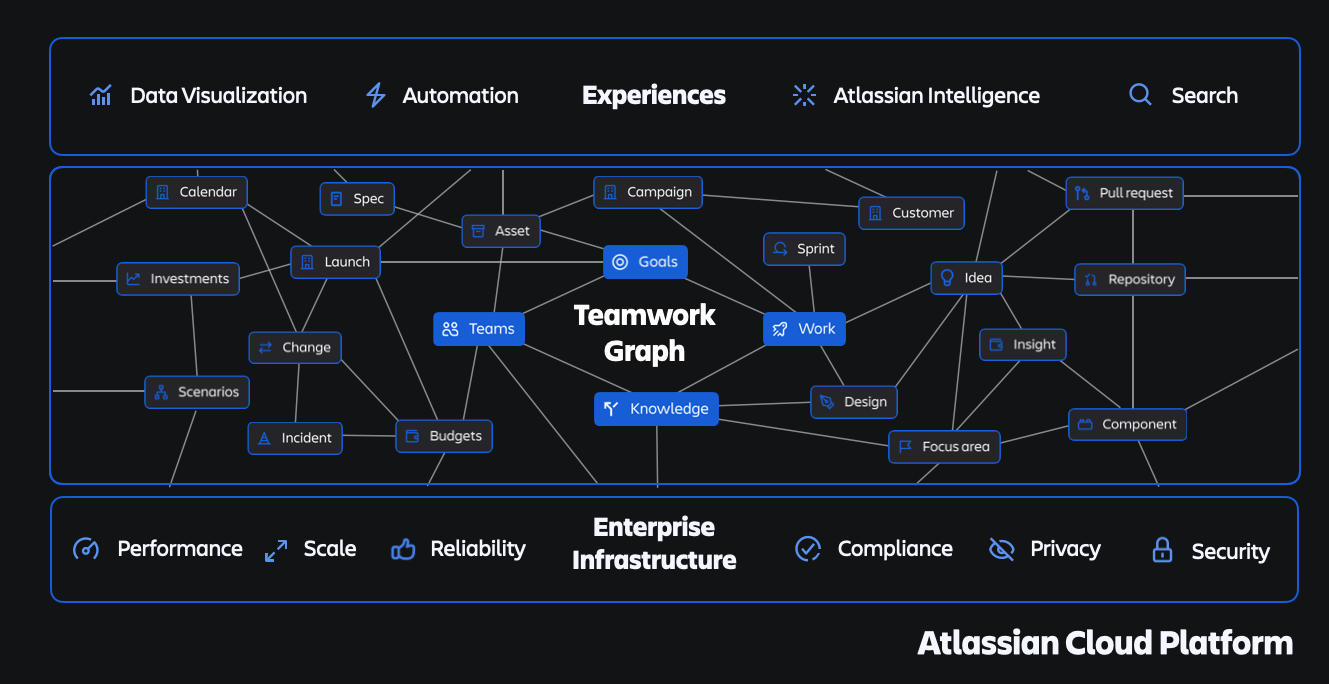
Atlassian’s powerful cloud platform makes all of this possible. We are constantly increasing scalability for larger enterprises, with plans to support up to 150,000 users in Confluence going into General Availability by the end of this calendar year and 100,000 users in Jira now on our public cloud roadmap. We’re also working on adding more admin features, like Portfolio Insights which lets admins better understand their product footprint, and Command Line Interface to help our customers scale.
As a further commitment to expanding our compliance standards, Atlassian joined the EU AI Pact, and we expect to achieve SOC 2 and ISO 27001 for Rovo by the end of the year.
Ultimately, our platform spans software, IT, and business teams, and we’re seeing this differentiation and long-term focus pay off. We believe Jira’s broad capabilities, from work management and issue tracking to change management and collaboration are why Atlassian has once again been named a Leader in the Gartner Magic Quadrant™ for DevOps Platforms3.
Atlassian was also named a Leader in The Forrester WaveTM: Enterprise Service Management, Q4 2023, with Jira Service Management receiving the highest possible score in the strategy category. Separately, a recent Forrester research report cited Atlassian as one of two IT management software vendors having reached dominant positions in the market:
IT management tools, referred to as the IT control plane, have been consolidating for years. A bipolar market is emerging, centering on ServiceNow and Atlassian, which have achieved critical mass that competitors will find hard to match.”4
 Strengthening Executive Leadership
Strengthening Executive Leadership
As part of continuing to seize the opportunities ahead, particularly in the enterprise, we are thrilled to announce the appointment of Brian Duffy as Atlassian’s new Chief Revenue Officer. Brian’s experience in sales transformations is vast with nearly two decades in the technology industry. Brian spent 18 years at SAP, and in his role as President of Cloud, Brian launched, built, and scaled ‘RISE with SAP’, a strategic initiative to move customers to the cloud. Through agility, focus, and innovative migration practices, Brian was able to grow RISE from an initiative to a multi-billion dollar business in the span of two years.
Brian took that experience to his most recent role as CEO of SoftwareOne where he set the company up for its next phase of growth and deepened relationships with customers and partners. Beyond the leadership Brian will bring in Sales and Customer Success, his public company CEO experience will bring unique depth and breadth to our amazing exec team.
Brian will officially join us on January 1, 2025. We can’t wait to have him join the team.
I’m pleased with the progress we’ve made in the first quarter of FY25 and continue to be optimistic about the significant opportunities ahead. Our years of effort in building a world-class cloud platform are paying off, particularly in the AI era. Our System of Work philosophy is increasingly being adopted by technology-driven organizations, and our products continue to be the cornerstone for how millions of teams get work done.
It’s the unique combination of the Atlassian platform, our System of Work philosophy, our AI strategy and our portfolio of products that gives me confidence in our ability to achieve our mission of unleashing the potential of every team.
-Mike

Financial Highlights
First quarter fiscal year 2025 financial summary
(U.S. $ in thousands, except per share data and percentages)
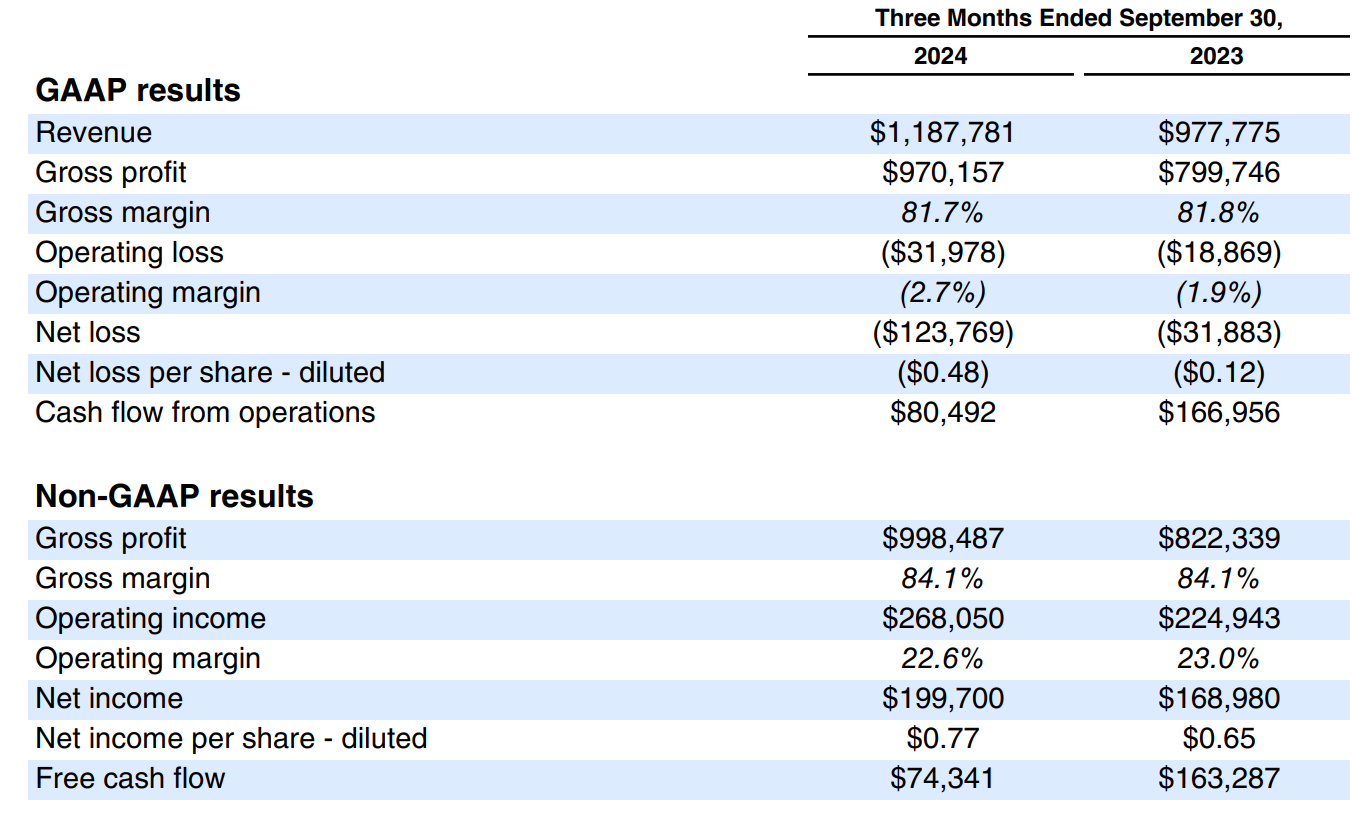
First quarter fiscal year 2025 highlights
Continued enterprise momentum and steady sales execution drove a solid start to our fiscal year with revenue, gross profit, and operating income exceeding our expectations. Revenue growth was primarily driven by paid seat expansion, higher average revenue per user (ARPU), and migrations. Gross profit and operating income benefitted from revenue outperformance and our continued focus on disciplined cost management. Overall, we delivered healthy financial results in Q1’25 despite the challenging year-over-year comparison created by Server end-of-support (EoS) dynamics in FY24.
Our product and engineering teams continue to deliver incredible innovation and customer value through the power of our enterprise-grade cloud platform, rapid advancements in AI, and the Atlassian System of Work. Enterprise customers are increasingly looking to Atlassian as a strategic partner to help their business and technology teams plan and track work, align on goals, and share knowledge across their organization. Our focus continues to be on executing against our key strategic priorities which pave the way for customers to unleash the full potential of their teams while driving durable long-term growth for our business.
Highlights for Q1’25 include:
All growth comparisons below relate to the corresponding period of last year, unless otherwise noted.
- Revenue of $1,188 million increased 21%, driven by growth in our Cloud and Data Center offerings, partially offset by the cessation of Server maintenance revenue following its EoS in Q3’24.
- GAAP gross margin of 82% and non-GAAP gross margin of 84% were flat.
- GAAP operating loss was $32 million, and GAAP operating margin of (3%) decreased one percentage point. Non-GAAP operating income was $268 million, and non-GAAP operating margin of 23% was flat.
- Operating cash flow of $80 million decreased 52%, driven by higher annual employee bonus payouts, partially offset by stronger collections. Free cash flow of $74 million decreased 54%.
Lastly, we are pleased to announce a new share repurchase program of up to $1.5 billion that will commence upon the completion of our existing $1.0 billion program. The new program, which has no expiration date, further underscores our confidence in our business, conviction in our significant long-term opportunities, and view that our shares are undervalued. Our demonstrated ability to generate consistent free cash flow allows us to opportunistically return capital to stockholders while continuing to invest to drive durable long-term growth.
Revenue
(U.S. $ in thousands, except percentage data)

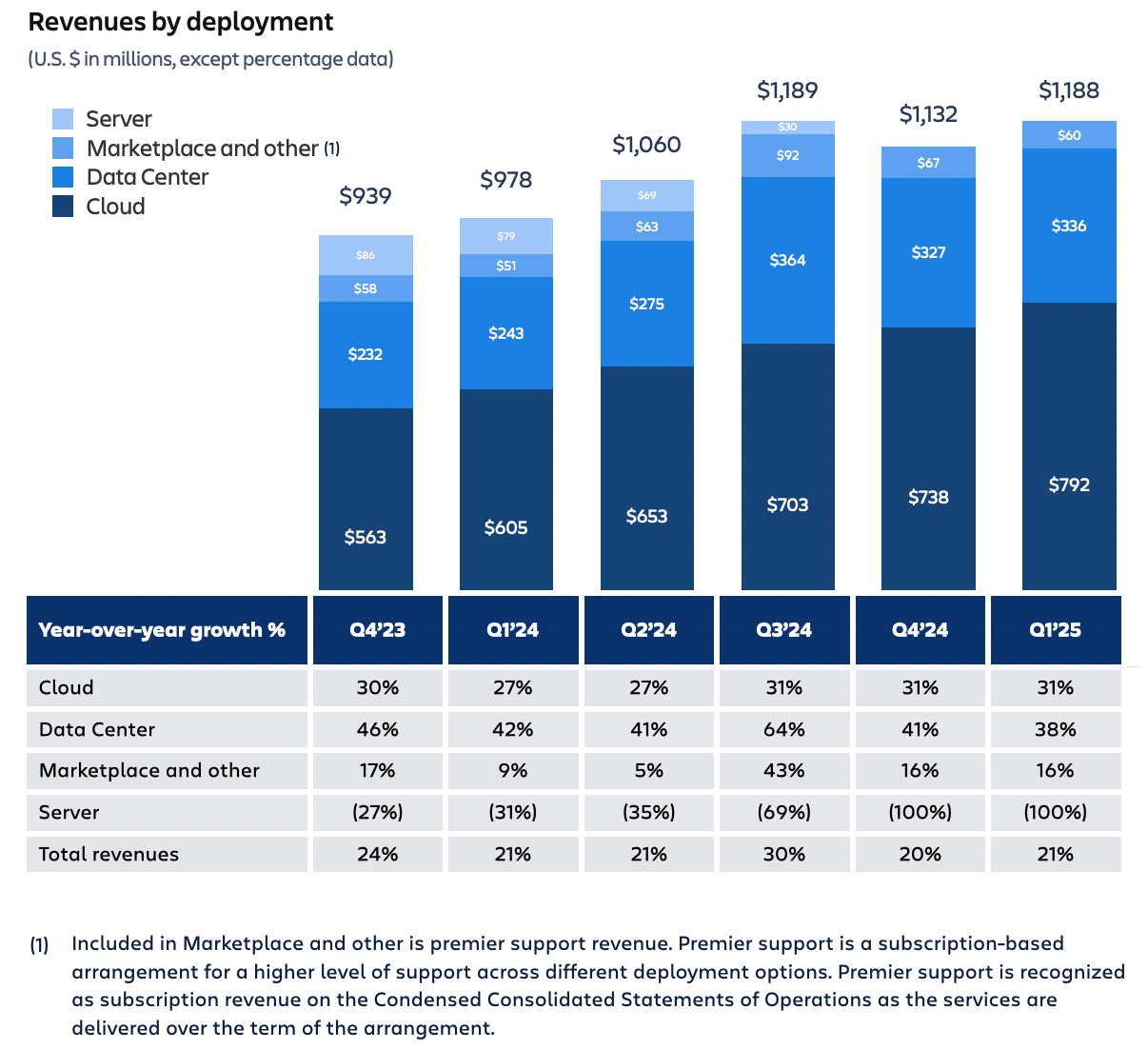
Revenue growth in Q1 was driven by subscription revenue, which grew 33%.
Cloud revenue growth of 31% was driven by paid seat expansion in existing customers, migrations, and cross-sell of additional products such as Jira Service Management and Guard, as well as encouraging traction with emerging products like Loom and Jira Product Discovery. Overall, trends in the quarter were consistent with the prior quarter as paid seat expansion in existing customers and migrations exceeded our expectations, while cross-sell of additional products, adoption of higher-value editions, top-of-funnel performance, and customer retention performed in line to slightly ahead of our expectations.
Data Center revenue growth of 38% was driven by prior-year Server migrations, price increases, and seat expansion in existing customers, partially offset by continued migrations to Cloud. Renewal rates, realized price increases, and seat expansion were slightly ahead of our expectations, highlighting the mission-critical nature of our products.
Marketplace and other revenue growth of 16% was driven by continued momentum in third-party app purchasing related to the Cloud and Data Center billings in the quarter.
Lastly, deferred revenue increased 34% year-over-year to $2.0 billion driven by continued customer commitment to the Atlassian platform.
Margins, operating expenses, and operating income (loss)
(U.S. $ in thousands, except per share data and percentages)
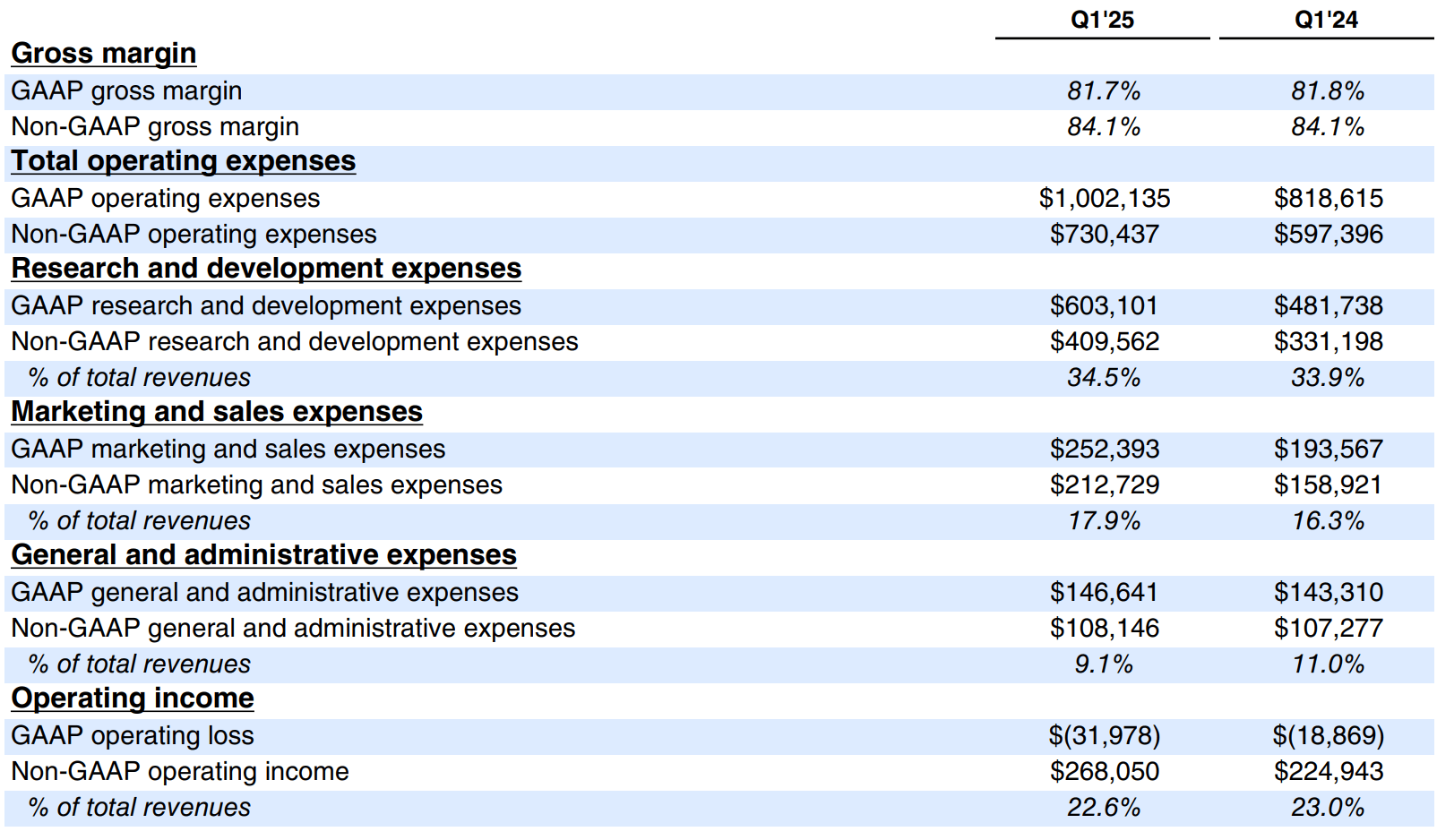
GAAP operating expenses increased 22% year-over-year driven by higher employment costs, including stock-based compensation expenses. Headcount at the end of Q1’25 was 12,501, an increase of 344 from the prior quarter, driven by hiring in R&D and sales as we continue to invest in key strategic priorities such as serving our enterprise customers, delivering AI innovation, and further bringing together technology and business teams with the Atlassian System of Work.
Non-GAAP operating expenses increased 22% year-over-year and were lower-than-expected driven by lower discretionary spending and employment expenses.
GAAP operating margin of (3%) and non-GAAP operating margin of 23% exceeded our expectations driven by better-than-expected operating leverage.
Net income (loss)
(U.S. $ in thousands, except per share data)

Free Cash Flow
(U.S. $ in thousands, except percentage data)

As a reminder, our free cash flow results experience quarterly seasonality, with Q1 typically having the lowest free cash flow of the year due to annual employee bonus payments in the quarter. The increase in bonus payment from the prior year was driven by higher attainment relative to target and a year-over-year increase in headcount.
Customers with >$10,000 in Cloud ARR
We ended Q1’25 with 46,844 customers with greater than $10,000 in Cloud annualized recurring revenue (“Cloud ARR”), an increase of 17% year-over-year. We continue to add enterprise-grade capabilities and new product innovation on the cloud platform with the General Availability of Rovo, Jira Product Discovery Premium, Compass Premium, and Guard Premium. This all comes on the heels of achieving FedRAMP® “In-Process” designation just a few months ago. Our steady execution against our cloud roadmap builds customer trust and further underscores our belief that Cloud is the ultimate destination for the largest enterprises.

Financial targets (U.S. $)
Q2’25
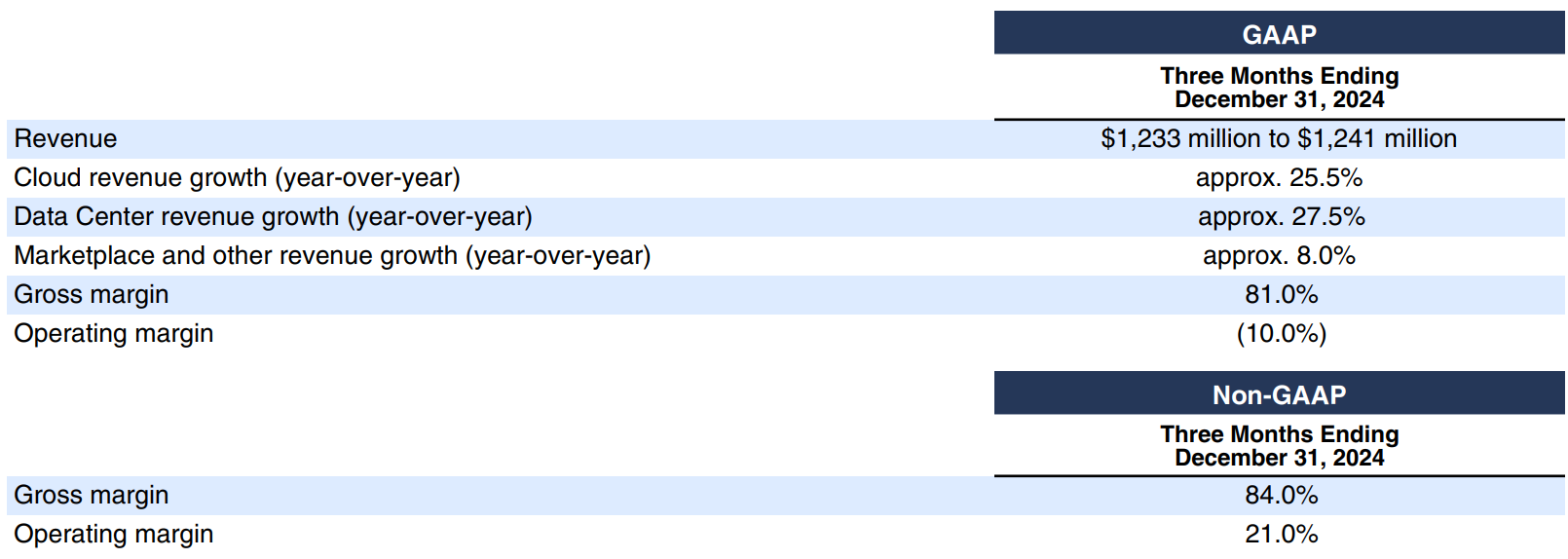
FY25
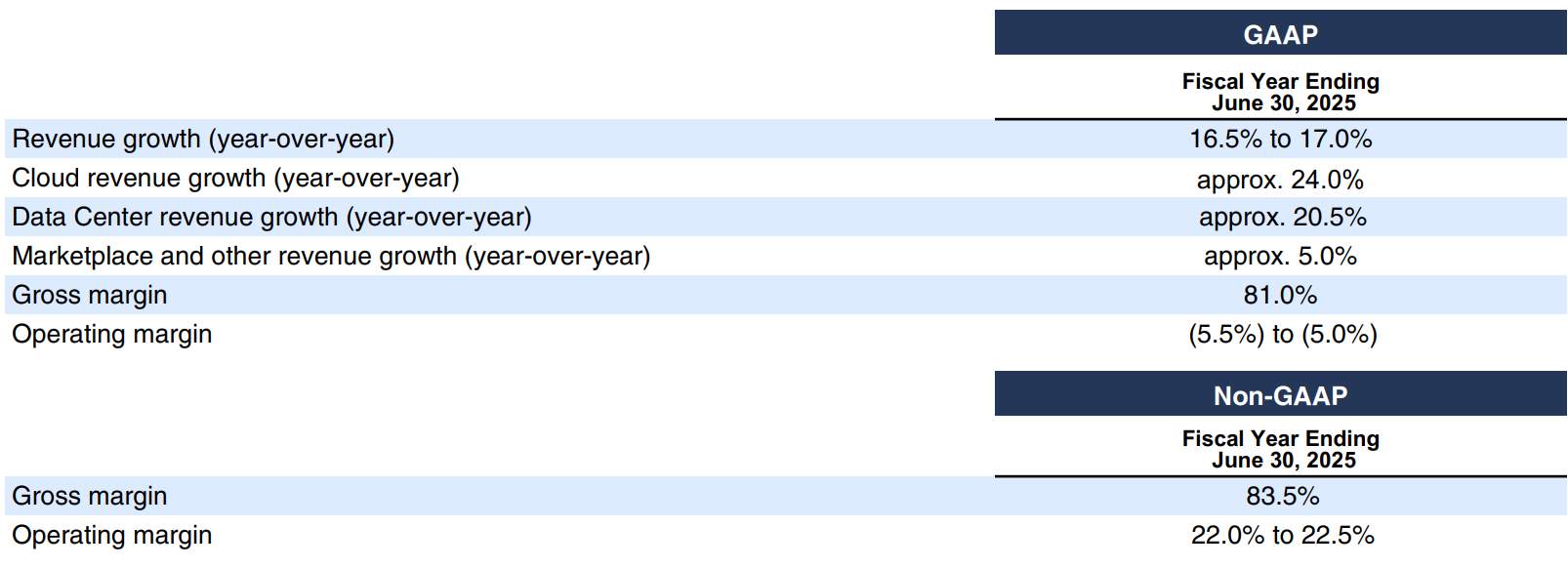
FY25 Outlook
Total Revenue
We expect total company revenue growth to be in the range of 16.5% to 17.0% in FY25. We continue to take what we believe is an appropriately prudent and risk-adjusted approach in setting the outlook for our business based on two primary factors.
First, given continued uncertainty in the macroeconomic environment, our guidance contemplates macro-related factors that would negatively impact revenue growth drivers such as paid seat expansion, cross-sell of additional products, upsell to higher-value editions of our products, and customer retention.
Second, while we continue to make progress in serving the enterprise and are excited to welcome Brian Duffy as our new Chief Revenue Officer in January 2025, our outlook continues to allow for execution risk in the ongoing evolution of our enterprise go-to-market motion.
Additionally, as a reminder, we will be lapping the impacts of Server EoS that benefited revenue in FY24. These dynamics create challenging year-on-year comparisons in FY25 in three primary areas:
- Event-driven Data Center and Marketplace outperformance in Q3’24
- Roll-off of FY24 Server migration benefits in both Data Center and Cloud
- Cessation of Server maintenance revenue
Further detail and commentary are provided below:
Cloud revenue
We have increased our Cloud revenue growth outlook to approximately 24.0% year-over-year in FY25. We continue to assume migrations will drive a mid-single-digit revenue growth contribution. While we are encouraged by our performance in Q1’25, we are maintaining a risk-adjusted outlook due to the factors described above.
As we deepen our relationships with our largest and most complex Data Center customers, they continue to express their strong desire to migrate to the Cloud and take advantage of the differentiated value of the Atlassian cloud platform through capabilities like automation, analytics, and AI. We expect this cohort of customers to migrate over a multi-year period and increasingly adopt hybrid deployment strategies.
In terms of seasonality, we expect Cloud revenue growth rates will decelerate in the second half of the year as we lap the impact of the Loom acquisition, with Q3 facing the most challenging year-over-year comparison due to Server EoS-related migrations in the prior year.
Data Center revenue
We expect Data Center revenue growth of approximately 20.5% year-over-year in FY25 driven by pricing, seat expansion in existing customers, and cross-sell of additional products. We expect growth to decelerate in the second half of the year as we lap the event-driven purchasing from Server EoS in Q3 and drive increasing migrations to the Cloud.
Marketplace and other revenue
We expect Marketplace and other revenue growth of approximately 5.0% year-over-year in FY25. The deceleration in the growth rate from FY24 is driven primarily by the challenging year-over-year comparison related to the event-driven purchasing from Server EoS, as well as continued sales mix shift to Cloud apps.
As a reminder, there is currently a lower Marketplace take rate on third-party Cloud apps relative to Data Center apps to further incentivize cloud app development.
We continue to expect Marketplace revenue growth to reaccelerate in FY26 as we lap the impact of Server EoS and continue to focus on driving strong third-party Cloud app attach to our first-party Cloud solutions.
Gross margin
We expect GAAP gross margin to be approximately 81.0% and non-GAAP gross margin to be approximately 83.5% in FY25, a decrease from the prior year driven by continued revenue mix shift to Cloud.
Operating margin
We expect GAAP operating margin to be in the range of (5.5%) to (5.0%) and non-GAAP operating margin to be in the range of 22.0% to 22.5% in FY25. Operating expense growth will be driven by our continued investments in R&D and sales and marketing to support our strategic priorities of enterprise, AI, and delivering innovation across the product portfolio, partially offset by continued efficiency gains in G&A as we scale. And as a reminder, operating margin in FY24 benefitted by 2 percentage points from the event-driven revenue outperformance related to Server EoS in Q3.
We remain confident in our ability to expand operating margin over time and are committed to delivering non-GAAP operating margin of 25%+ by FY27 driven by durable revenue growth and a continued focus on driving operating efficiencies across the business.
SHARE COUNT
We continue to expect diluted share count to increase by 1 to 2% in FY25.
1 The Total Economic Impact™ of Jira Service Management, a commissioned study conducted by Forrester Consulting, 2024. Results are for a composite organization based on interviewed customers.
2 Gartner, Elevate Your Discussion to Drive Strategy Execution, Anthony Henderson, January 9, 2024.
3 Gartner, Magic Quadrant for DevOps Platforms, Keith Mann, Thomas Murphy, Bill Holz, George Spafford, et al, 3 September 2024.
4 Forrester. “Vendors Move to Dominate IT Management Software” Charles Betz, Julie Mohr. 11 July 2024.
Gartner does not endorse any vendor, product or service depicted in its research publications and does not advise technology users to select only those vendors with the highest ratings or other designation. Gartner research publications consist of the opinions of Gartner’s research organization and should not be construed as statements of fact. Gartner disclaims all warranties, expressed or implied, with respect to this research, including any warranties of merchantability or fitness for a particular purpose.
The Gartner content described herein (the “Gartner Content”) represents research opinion or viewpoints published, as part of a syndicated subscription service, by Gartner, Inc. (“Gartner”), and is not a representation of fact. Gartner Content speaks as of its original publication date (and not as of the date of this Shareholder Letter), and the opinions expressed in the Gartner Content are subject to change without notice.
GARTNER is a registered trademark and service mark of Gartner and Magic Quadrant is a registered trademark of Gartner, Inc. and/or its affiliates in the U.S. and internationally and are used herein with permission. All rights reserved.


